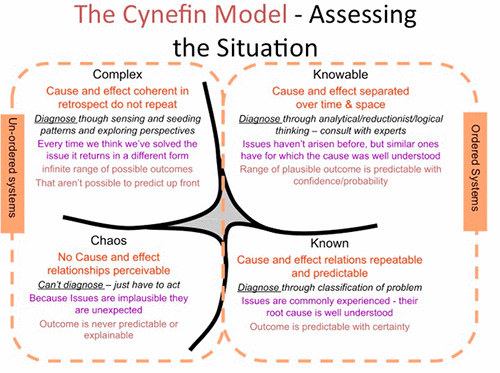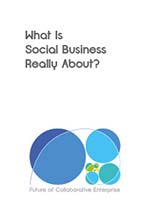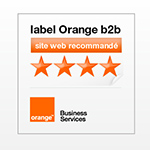Les réseaux mettent en évidence la culture et la politique de l’organisation
Michael Schrage
Ce billet a été co-écrit avec Jon Husband, et sa version anglaise est disponible sur wirearchy.com
 Au fur et à mesure de l’évolution de notre monde en réseaux, les modèles normatifs, comportant des règles pour tout, deviennent de moins en moins efficaces. Face à la complexité et à l’incertitude, nous, leaders, dirigeants et consultants, sommes souvent confrontés à la tentation de retomber dans une logique linéaire de cause-à-effet trop normative. Nous enfilons ainsi, sans même souvent y réfléchir, des carcans sémantiques.
Au fur et à mesure de l’évolution de notre monde en réseaux, les modèles normatifs, comportant des règles pour tout, deviennent de moins en moins efficaces. Face à la complexité et à l’incertitude, nous, leaders, dirigeants et consultants, sommes souvent confrontés à la tentation de retomber dans une logique linéaire de cause-à-effet trop normative. Nous enfilons ainsi, sans même souvent y réfléchir, des carcans sémantiques.
Les carcans sont à l’origine le dispositif par lequel au cours du Moyen Age, on attachait les criminels au pilori. Par extension, « carcan » a dénommé le collier de fer passé au cou des forçats ou celui, en bois, passé au cou du bétail, afin de contraindre leurs mouvements, voire de les immobiliser. De même manière, la sémantique nous entrave.
De nos jours, le discours sous-jacent à la logique, linéaire et normative, de cause-à-effet héritée de la révolution industrielle constitue un véritable carcan. Nous cherchons à savoir comment faire mieux, plus vite, moins cher, à plus grande échelle.
Les modèles créés pour codifier ce « comment faire mieux, plus vite, moins cher » sont quasi exclusivement dérivés de la « science » dominante du management d’aujourd’hui et d’hier. Ces modèles nous ont directement conduits vers les processus modernes, redessinés, optimisés et rationalisés qui nous entourent dans notre vie de tous les jours. Les processus, modèles de compétences, modèles de management et de leadership actuels ont tous pour objectif ce type de comportement orienté vers la performance à court terme.
Ils sont devenus si courants et si largement diffusés que l’on les utilise presque sans y penser. De ce fait, comme ces mots à la mode qui peuvent représenter une idée valable, mais dont le sens s’est dilué en se popularisant et à travers une utilisation dénuée de sens critique, beaucoup de ces modèles ont perdu l’essentiel de leur sens dans notre nouveau contexte.
Ils rivalisent pour attirer l’attention d’utilisateurs potentiels. Et ils ont pour effet inattendu de créer et de faire perdurer des limites à l’action et à l’interaction, limites qui sont autant d’obstacles à l’adaptation, à la réactivité et à la co-création d’innovation dans notre contexte. La phrase « sortir des sentiers battus » (think out of the box) prononcée pour encourager la créativité existe pour une bonne raison.
Pour tout résultat, alors que nous sommes confrontés à la complexité, à l’ambiguïté et à l’incertitude grandissantes, nous sommes sous la coupe d’un modèle mental qui nous exhorte à ignorer la confusion et à nous concentrer sur ce qu’il faut faire pour “gagner”. Je me rappelle un excellent exemple donné par Dave Snowden il y a quelques années, lorsque KPMG (je crois) promettait sur les affiches de “fendre la complexité et atteindre la solution”. Dave, en tant qu’autorité en matière de navigation au sein de la complexité, avait gloussé de dérision face à cette publicité présomptueuse.
La plupart des modèles offrent et promettent une meilleure efficacité organisationnelle – en d’autres termes, de gagner. Ce sont typiquement des combinaisons de “solutions” et de “transformation”, des recettes. Ils sont marquetés en tant que solutions, mais constituent essentiellement des ensembles de motifs observables au sein de contextes présumés stables et/ou répétables.
Plus souvent qu’à leur tour, ils font grand bruit au nom de l’assistance à davantage de réactivité et de capacité à naviguer au sein de la complexité grandissante, mais ne font rien ou presque pour développer ou cultiver une réactivité réelle, flexible et durable.
Mais ne vous y trompez pas. Au cours des 50 dernières années, en Occident (et partout sur terre), nous avons largement bénéficié de la codification et de la modélisation de l’efficacité, panifiant, budgétisant et approfondissant notre compréhension de la psychologie humaine dans le contexte de l’homo economicus.
Les méthodes et modèles du “comment” dominer
Nous avons vécu les derniers feux d’une ère dominée par des conjectures sur la prévisibilité, l’efficacité, la reproductibilité et le contrôle de la qualité, et par la quête permanente de remplacer du travail humain, cher et variable, par des processus et des automatismes permettant de délivrer ces caractéristiques à très grande échelle.
En grandissant et se poursuivant, cette quête du succès fiable et de l’amélioration continue a fini par définir notre époque. Au cours de cette évolution, nous avons pu observer (à travers une pléthore de modèles sémantiquement définis) l’évolution des concepts de la science du management :
- Division du travail
- Spécialisation opérationnelle
- Evaluation et supervision continues
- Adoption généralisée des métriques
- Et définition de ce que la performance souhaitable signifiait.
Ces outils (échelles, grilles et matrices sémantiquement définies) ont ainsi explicité divers niveaux génériques de responsabilité, de talents requis et de compétences définies en tant que “comment faire”. Plus récemment, nous avons vu apparaître des tentatives de lever les contraintes imposées par ces conjectures (comme par exemple le Balanced Scorecard, les méthodologies Lean et Agile, etc.).
Néanmoins, l’univers du management reste saturé de méthodes et de modèles du «comment faire» :
- Pour améliorer l’efficacité
- Pour exploiter le capital humain
- Pour mieux s’organiser afin de délivrer de manière plus fiable
Tous les modèles, à tous les niveaux
Il semble aujourd’hui que cette modélisation est devenue tout ce que nous savons et comprenons. Construire et implémenter des modèles est notre manière d’aborder les problèmes et les opportunités. Et relativement rapidement, ils deviennent la recette à suivre, tout en devenant malheureusement de moins en moins adaptés à un environnement de plus en plus complexe. Les dirigeants et les managers veulent savoir “ce qui va marcher” – sans avoir à effectuer le difficile travail de réflexion critique sur la dynamique humaine impliquée dans la cognition, dans l’apprentissage ou dans la communication efficace, et s’attacher à la résolution des problèmes en entretenant un feedback permanent.
Après plus de 75 années de science du management, nous avons forgé nos propres carcans. Nous avons sémantiquement construit les forces qui sont devenues autant d’obstacles à la flexibilité, à la réactivité et à l’innovation. Voici la liste de nos rescriptions actuelles:
- Des modèles de méthodologies Agiles et Lean qui “fonctionnent”, en opposition à leur utilisation en tant qu’orientation
- Le modèle organisationnel “unique” qui mène à la véritable performance
- Des modèles de compétences, des descriptions de poste, de plans de formation et des modèles managériaux fixes
- Le CV “parfait”
- Des “recettes” pour la gestion du changement et pour la transformation digitale / organisationnelle
L’adaptabilité durable et la véritable efficacité, dans un environnement où la complexité augmente, semblent insaisissables. Au mieux, nous voyons des améliorations dans la manière dont les choses sont traitées, faites et délivrées, mais elles sont presque toujours fugaces. Ensuite, tout change à nouveau, et adaptabilité et réactivité restent insaisissables. Que se passe-t-il donc ?
La complexité sans la compréhension
Ceci me rappelle le débat, souvent cité, entre l’applicabilité et l’utilité des modèles de Meilleures Pratiques contre ceux de Bonnes Pratiques. En effet, au lieu d’appliquer les meilleures pratiques comme des recettes, les bonnes pratiques impliquent d’explorer des modèles et d’utiliser des principes plus fondamentaux pour comprendre ce qu’il faut faire, pourquoi et comment le faire.
Avant la manie si répandue d’implémenter des systèmes ERP de façon massive et globale (dans un but de standardisation et mettant l’accent sur l’efficacité), au cours des années 80, nous avons de plus en plus entendu parler d’entreprises apprenantes, d’organisations en tant que systèmes humains vivants, et entendu des exemples de réussite concernant des expériences de groupes de travail autogérés et d’autogestion. Pourtant, la grande majorité de ces expérimentations a été écrasée par la déferlante de l’ERP-isation de l’entreprise.
Plus récemment, un intérêt grandissant s’est manifesté pour des concepts tels que la holacratie, prétendument orientée vers l’autogestion, pour les concepts émergents de l’Organisation Dynamique (Responsive Organization) de Microsoft et des Tribus, Guildes et Escouades (Squads, Tribes, Guilds and Agile Organizations) d’Holonomics. Ces nouveaux modèles mettent l’accent sur l’autogestion au sein de structures humaines, mais cherchent à créer un modèle qui puisse être implémenté à travers un ensemble de règles s’appliquant à des conditions nouvelles (des flux d’information et de feedback hyperliés et en réseaux).
Pourtant, alors que ces conditions impactent de plus en plus notre activité dans le contexte de l’entreprise, il n’est guère surprenant que les exemples les plus cités aujourd’hui en termes d’efficacité et d’adaptabilité concernent pour la plupart des entreprises citées il y a 20 ou 25 ans en tant qu’exemples d’entreprises apprenantes autogérées (W.L. Gore & Associates, Semco et une poignée d’autres).
L’univers de l’entreprise devient rapidement de plus en plus complexe. Parallèlement à cette complexité grandissante, se développe également un désir (et un appétit) pour les solutions simples et faciles à implémenter. Cette polarisation est compréhensible. Mais l’ être humain est brouillon, et chacun possède des compétences et des profils cognitifs, psychologiques et émotionnels qui lui est propre. L’homme se réduit difficilement à des modèles standardisés. J’ai le sentiment que la plupart des gens ont réagi à l’invasion des modèles de compétences (par exemple) de la manière dont réagirait quelqu’un à qui on imposerait un carcan… vivable, mais contraignant et inconfortable.
Comprendre et utiliser la complexité
Les réseaux hyper-liés qui nous ont connectés les uns aux autres et permis de nous exprimer, de travailler à haute vois (work out loud), rendent explicite la diversité de perspectives de l’être humain et le désordre qui lui est associé, et ont considérablement amplifié le problème que les modèles de la science du management cherchent à résoudre.
Notre confiance en ces modèles prescriptifs, sémantiquement définis, du « comment » faire, du « comment » réussir la prochaine fois, nous freinent. Je ne crois pas qu’il puisse encore exister de modèle « juste » permettant aux leaders et aux décisionnaires de générer de l’efficacité.
Peut-être, au lieu d’utiliser ces modèles pour essayer de contrôler et de prédire ce que pourront faire des êtres humains en réseau, dans notre quête de d’avantage de flexibilité, de réactivité et de “performance”, devrions-nous chercher à dompter ces activités en cherchant à comprendre la diversité et l’unicité, et en apprenant à fonctionner dans un environnement de plus en plus complexe.
Dave Snowden et ses collaborateurs ont développé le modèle Cynefin il y a une dizaine d’années. Son objectif est d’aider les dirigeants et les managers à naviguer plus efficacement au sein de conditions complexes.
Le modèle Cynefin permet aux dirigeants de voir les choses depuis de nouveaux points de vue, d’assimiler des concepts complexes, et de gérer des problèmes et des opportunités de la vraie vie. (Cynefin, prononcé ku-nev-in, est un mot irlandais signifiant les facteurs multiples dans notre environnement et dans notre expérience qui nous influencent d’une façon que nous ne pouvons pas comprendre). En utilisant cette approche, les leaders apprennent à définir le modèle au moyen d’exemples tirés de l’histoire de leur propre entreprise et de scénarios de son avenir possible. Ceci améliore la communication et aide les dirigeants à comprendre rapidement le contexte dans lequel ils opèrent.
…
Le modèle répartit les problèmes auxquels les dirigeants font face dans cinq contextes définis par la nature de la relation existant entre la cause et l’effet. Pour quatre d’entre eux – simple, compliqué, complexe et chaotique – les dirigeants doivent diagnostiquer les situations et agir de manière contextuellement correcte. Le cinquième – désordre – s’applique lorsqu’il est impossible de déterminer lequel des quatre autres contextes est prédominant.
«A Leader’s Framework for Decision-Making», Harvard Business Review, novembre 2007
Le modèle Cynefin (ci-dessous), et l’utilisation des possibilités de “faire sens” offertes par la suite logicielle Sensemaker sont essentiels pour aller au-delà des carcans sémantiques incarnés par les modèles de cause-à-effet nous expliquant « comment » faire.

Le modèle Cynefin nous confronte à une narration différente, à la fois sémantique et syntaxique, de la nature du travail en une époque de conditions en changement permanent et d’information continue. En devenant les utilisateurs réguliers d’un tel modèle, nous comprendrons mieux le type d’activités et de travail auxquels nous avons affaire, et le type de changement qui doit être envisagé.
Du point de vue sémantique, les indicateurs proposés par le modèle Cynefin sont des descriptions des conditions de base et des actions possibles. Au lieu de chercher à réduire – et souvent d’ignorer – la complexité, ces indicateurs ne sont pas des prescriptions mais incitent au contraire à la recherche, à la pensée critique et à l’analyse des possibles. La pensée critique et l’action mèneront ainsi à des réponses efficaces à la complexité, sans présenter de réponses standardisées.
Voici une interprétation simpliste des différents domaines de Cynefin:
- Simple – un travail / une activité établi et nécessaire, peu susceptible de beaucoup changer, et donc candidat à l’automatisation et / ou à la robotisation.
- Compliqué – un travail / une activité structuré, mais requérant un perfectionnement, pour lequel les analytiques, la recherché de motifs et l’algorithmisation sur un périmètre défini permettront une amé
- Complexe – un travail / une activité pour lequel la recherche et l’observation de motifs récurrents, et la décision sur les contraintes à prendre en compte pour clarifier ces motifs offrent des possibilités de stabilisation et d’amélioration continue, et
- Chaotique (et/ou dés-ordonné) – un domaine dans lequel l’action, l’expérimentation autour de stimuli et de contraintes sont requis pour faire émerger des motifs
De plus, ce modèle ne présente pas de chemin linéaire, prévisible, d’un domaine à l’autre. Il ne donne ni réponse prescriptive, ni approche séquentielle de la manière dont les choses doivent se faire. Sa syntaxe ouverte favorise l’expérimentation, la réflexion oblique, et la compréhension globale des motifs en présence.
Des modèles sémantiques pour donner une ligne directrice, non pour contrôler
Pour déverrouiller les carcans qui entravent notre capacité à nous adapter favorablement aux conditions présentes et futures, nous devons devenir capables de discerner entre les différents domaines définis dans le modèle Cynefin, considérer des approches de la complexité différentes de celles impliquant la complication, des approche de l’inconnu différentes de celles de ce que nous connaissons.
Des modèles tels que Cynefin nous ouvre la voie vers une sémantique nouvelle, et leur syntaxe ouverte nous permet de rester à l’écart des recettes qui étaient à l’honneur dans un environnement prévisible, afin de prototyper et d’appliquer des approches novatrices à “l’efficacité” de l’entreprise.
Bien sûr, ce n’est pas là tâche facile. Mais tandis les modèles à base de recettes, avec leurs ensembles exhaustifs de règles, ont toutes les chances de devenir de moins en moins efficaces au fur et à mesure de l’évolution de notre monde en réseau, nous ne pouvons plus nous réfugier derrière eux par peur de la complexité.
Pour apprivoiser cette peur, et accroître notre potentiel tant individuel que collectif, nous devons commencer à apprendre les fondamentaux d’une nouvelle sémantique, et jouer avec eux selon une nouvelle syntaxe. L’apprentissage et le jeu, et non plus les méthodologies prescriptives, sont la trame de l’amélioration organisationnelle.
 Nos organisations sont en mauvaise santé, ce n’est plus un secret pour personne. Plus un jour ne passe, sans que ce constat ne soit discuté, disséqué, tant dans ses causes que dans ses effets, ni sans que les pratiques hiérarchiques et bureaucratiques en exercice dans de très — trop — nombreuses entreprises ne soient montrées du doigt, et présentées comme les vestiges toxiques des structures qui se sont développées et ont régné en maître dans une période marquée par la révolution industrielle.
Nos organisations sont en mauvaise santé, ce n’est plus un secret pour personne. Plus un jour ne passe, sans que ce constat ne soit discuté, disséqué, tant dans ses causes que dans ses effets, ni sans que les pratiques hiérarchiques et bureaucratiques en exercice dans de très — trop — nombreuses entreprises ne soient montrées du doigt, et présentées comme les vestiges toxiques des structures qui se sont développées et ont régné en maître dans une période marquée par la révolution industrielle.

 Au fur et à mesure de l’évolution de notre monde en réseaux, les modèles normatifs, comportant des règles pour tout, deviennent de moins en moins efficaces. Face à la complexité et à l’incertitude, nous, leaders, dirigeants et consultants, sommes souvent confrontés à la tentation de retomber dans une logique linéaire de cause-à-effet trop normative. Nous enfilons ainsi, sans même souvent y réfléchir, des carcans sémantiques.
Au fur et à mesure de l’évolution de notre monde en réseaux, les modèles normatifs, comportant des règles pour tout, deviennent de moins en moins efficaces. Face à la complexité et à l’incertitude, nous, leaders, dirigeants et consultants, sommes souvent confrontés à la tentation de retomber dans une logique linéaire de cause-à-effet trop normative. Nous enfilons ainsi, sans même souvent y réfléchir, des carcans sémantiques.




